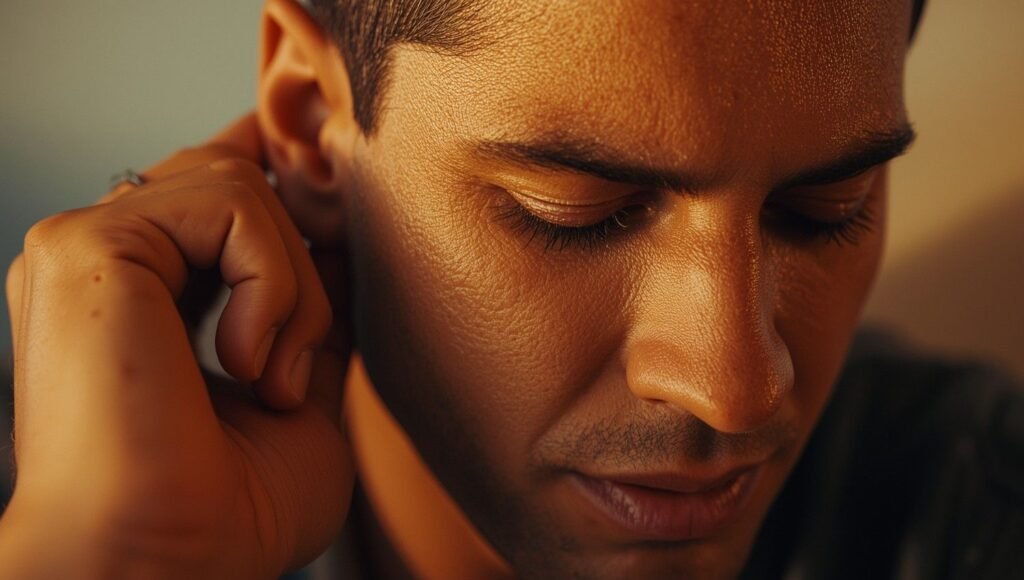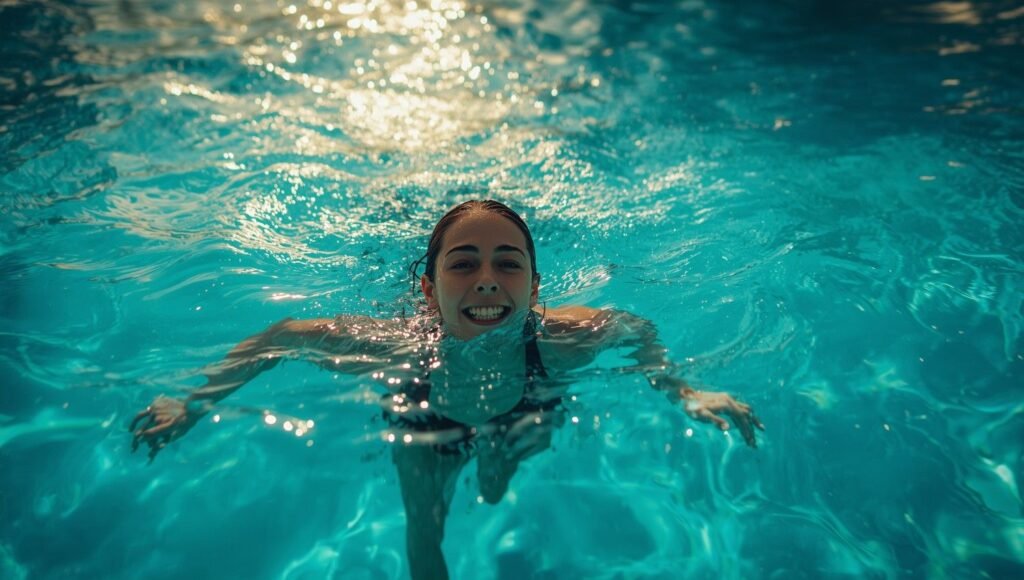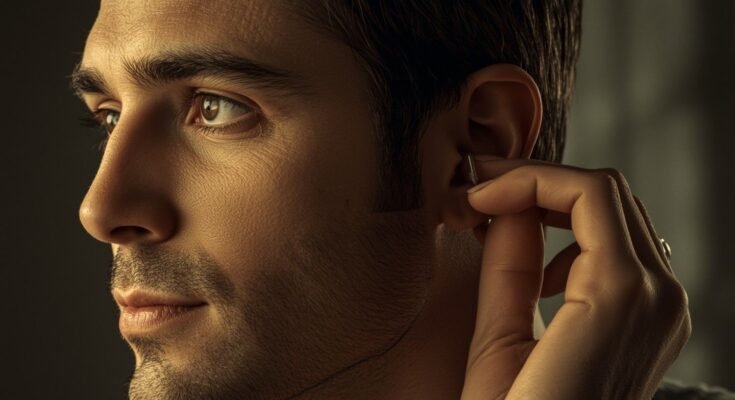Introduction
After swimming or even taking a bath, I know the strange feeling when water gets stuck inside the ear. A simple tilting of the head down can sometimes help, or even placing a facial tissue near the ear to let the excess water out. From my own experience, it feels like the ears need to pop, and the annoying pressure can affect hearing. If the outer ear canal stays wet, it can cause an infection like swimmer’s ear, where moisture lets bacteria or fungi grow. That’s why being cautious and keeping the ear canal clean and dry is important. To prevent water in the ears, I often use earplugs bought over the counter at drug stores before bathing or swimming.
When Water Gets Trapped?
A fun day at the pool or even a quick shower can turn uncomfortable once water becomes trapped in the ear. The fullness, muffled hearing, and discomfort are things many of us have experienced. While it’s rarely a serious problem, it’s essential to avoid further issues like swimmer’s ear. This article explains safe and effective ways to remove water from the ear and reminds you to consult a healthcare provider if the trouble continues.
This article explains safe and effective ways to remove water from your ear and when you may need to consult a healthcare provider

Simple Actions for Removing Water From Your Ear
At home, there are simple steps that can bring quick relief when water gets stuck in the ear after swimming or showering. The goal is to let the water flow out naturally, and there are several techniques to help. From my own trials, I’ve discovered that some safe and effective methods are easier than you’d expect. A guide of quick fixes and tips can keep you from facing future issues, and it feels good knowing you’ve got it covered.
When trapped water leads to discomfort or reduced hearing, the risk of ear infections such as swimmer’s ear becomes real. In such times, an intervention may need medical attention, especially if the problem is persistent. For immediate relief, I’ve used techniques like tilting the head, jiggling the earlobe, or applying a warm compress. Even creating a vacuum with the palm, or relying on evaporation with a blow dryer, can help. Long-term, preventive measures like wearing earplugs, addressing ear health buildup, and preventing water entrapment are key to maintaining overall ear wellness.
Understanding Water in the Ear
Water often becomes trapped in the ear after everyday activities like swimming, diving, or even showering. This can cause symptoms such as muffled ear sensation, rustling noise in the ear canal that feels like gurgling, or a tickling sensation spreading toward the jawbone or throat. Many people notice difficulty hearing, along with an issue of ongoing discomfort. The accumulation of water in the ear can also cause inflammation in the ear canal, especially when salt or chlorine weakens the ear’s protective film. This makes the ear more open to pathogens, increasing the risk of infections such as swimmer’s ear, an outer ear infection that can persist for days. While self-care measures may help, some cases need medical attention, especially when there is pain, recurring inflammation, or even intense fever linked to a middle ear infection.
I’ve experienced that a little tickle in the ear after swimming can quickly turn into a full sensation, leading to trouble hearing and feeling as if the water is stuck in the ear canal. This kind of trapped water in the ears can be a source of annoyance, and if not handled properly, may trigger an infection like swimmer’s ear. Thankfully, a practical guide of steps can help drain water from the ears and prevent repeat problems. Sometimes, it just takes the right approach to let the water draining begin—so you don’t feel quite as stuck and can jump back into your routine with comfort.

Jiggle Your Earlobe to Get Water out of Your Ear
This method may help you expel the water that’s trapped in your ear quickly. By tilting your head downward toward your shoulder, you can jiggle or tug the earlobe. Gently pull the earlobe up, down, or even side-to-side to help the liquid shift. Sometimes, a light massage or a little bob of the head toward the ground while it’s tilted can remove the trapped water.
Create a Vacuum Using the Palm of Your Hand
Using a vacuum with your palm and hand can pull the ear free of moisture. While tilting the blocked ear toward the ground, place your palm flat and start pumping gently. With some practice, you’ll feel a vacuum sensation. Adjust the position of your palm to make a seal over the ear. If you have long hair, tuck it to the side so it doesn’t interfere. Even a slight vacuum can give the water the push or encouragement it needs to vacate the ear.
Try the Blow Dryer Method
The blow dryer method uses hair heat to evaporate ear canal–trapped water. Turn on the blow dryer at the lowest setting and keep it in a safe position about 30 centimetres from the ear. As you pull the earlobe, move the dryer so warm air gently enters the ear. This keeps it safe while encouraging dryness.
Add More Water To Your Ear
Though it sounds odd, this method uses more water in the ear as a technique. By adding a bit of extra water, you can sometimes draw out the trapped water. Lie on the body side opposite the affected ear, and drip water in with a dropper. Wait a few seconds, then flip so the ear faces downward. Often, the trapped liquid will drain out along with the new water.
Apply Eardrops
Eardrops can be made from a mixture of vinegar and isopropyl alcohol, also called rubbing alcohol. A pharmacist can help you purchase ready-made solutions. To use, apply a few drops into the affected ear, wait a few seconds, then tip your head and hold a tissue by the ear to catch the liquid. Both antimicrobial and quick to evaporate, the alcohol removes residual water. But don’t try this if you have an eardrum perforation, an ear infection, pain, swelling, discharge, or discomfort. Also, avoid if you have eardrum tubes or tympanostomy tubes. If you feel pain or discomfort, stop using eardrops and seek medical advice.
Immediate Actions to Release Trapped Water
If water is trapped in the ear, try to shake it loose. Jiggling the earlobe can help remove of water through small motions that may dislodge it. Even a gentle tug on the earlobe supports the process. Another method is to tilt the head toward the shoulder, with the affected ear pointing downward. This allows the flow of trapped water and speeds removal thanks to gravity. In some situations, ear tubes may be placed by a healthcare professional to improve natural drainage.
Gentle Methods to Dislodge Water
Gentle methods to dislodge water include creating a vacuum in the ear by adjusting pressure in the ear canal. Avoid cotton swabs, as they can push water deeper into the ear canal. One method is to tilt the head sideways, press your ear against your palm, and make a seal. Then, rub your hand in a gentle manner. Another method is using a compress of heat on the area, which encourages drainage of water and eases relief from discomfort. Even taking a hot shower helps, since steam can aid drainage.
The Role of Evaporation Techniques
Evaporation techniques rely on warming the water in the ear until it disappears. A blow dryer is one method, where gentle heat allows evaporation inside the ear canal. Keep the dryer on the lowest setting and at a safe distance from the ear so only warm air reaches it. Ideally, hold the dryer about 12 inches away from hair and skin to avoid harmful contact. This way, the dryer supports safe removal of water in the ear.
Over-the-Counter Solutions
Some solutions from the counter work well, including eardrops and sprays. These counter solutions are designed to clear water from the ear. Many drops use isopropyl alcohol and glycerin, but it’s smart to speak with a healthcare professional before choosing the right eardrops. Pick the option carefully, since even solutions at the counter should be used under a doctor’s recommendation and supervision to avoid complications.

Advanced Techniques for Stubborn Cases
In stubborn cases where water stays trapped in the ear, stronger methods may be needed. Some advanced techniques involve using alcohol and vinegar drops. This technique is helpful in persistent cases but should only be done under medical supervision. Mixing rubbing alcohol and vinegar may cause discomfort if the eardrum is perforated, and too much rubbing alcohol can lead to toxicity.
To try this, combine equal parts of each, place a few drops in the ear, wait several minutes, then tilt your head so the solution and water can drain. Another technique uses hydrogen peroxide ear drops, but because of the risk of irritation or danger with a perforated eardrum, it should only be done under medical supervision.
Recognizing When It’s More Than Just Water
Sometimes, water trapped in the ear is not the only issue. Certain symptoms may signal a different condition, such as ear infections, pain, or muffled hearing. The buildup of earwax may worsen the condition, and an infection like swimmer’s ear can develop. Common symptoms include pain, muffled ear sounds, and ongoing discomfort.
If earwax is trapped along with water, using eardrops may soften the wax. But inserting objects into the ear canal risks damage. When the condition involves infection, earwax build-up, or doesn’t clear up, seek medical advice.
Preventative Measures for Future Protection
Keeping water out of the ear starts with preventative measures. To avoid recurrence, wear earplugs or use custom hearing protection. These strategies lower the chance of water entrapment in the ear. Soft silicone or putty earplugs are common options that help in preventing water from entering the ears, thanks to their strong sealing properties.
Custom hearing protection, such as earmolds or tailored earplugs, fits the ear perfectly and creates a reliable barrier in the ear canal. These preventative measures help preserve ear health and reduce discomfort caused by water in the ear.
Addressing Related Ear Health Concerns
Beyond trapped liquid, ear health concerns like earwax buildup, swimmer’s ear, or vertigo also matter. The accumulation of earwax may block proper drainage of water in the ear canal, causing symptoms such as earache or hearing impairment.
Swimmer’s ear, also called otitis externa, is an infection in the outer ear canal, often linked to water exposure and bacterial growth. Trapped water may also cause vertigo, bringing feelings of imbalance or spinning, sometimes tied to effusions or cold water affecting the inner ear balance. By addressing these health concerns, you protect long-term ear health and avoid complications from the accumulation of water in the ear.
Leverage Gravity
Sometimes gravity is all you need. Tilt your head to the side so the affected ear is pointing downward. Gently pull on the earlobe to open the ear canal, helping water drain out. Lying on your side with a towel under your head can also work.
Create a Vacuum
To form a vacuum, keep your head tilted and cup your palm or hand over the ear to make a seal. A light suction can help dislodge the water, often without any other effort.
Use a Little Movement
Even a small movement can help. Working the jaw by chewing gum or yawning opens the eustachian tubes, making it easier for water to drain.
When To Use Eardrops
If simple tricks don’t work, eardrops may be worth trying. Different methods exist: some are store-bought products, others are counter solution mixes. A homemade mixture of rubbing alcohol and vinegar can help. The alcohol dries the ear, while the vinegar loosens earwax that might be trapping water. Use a dropper to place a few drops in the ear, then tilt your head to let the liquid drain.
Avoid eardrops if you have an infection, a perforated eardrum, or ear tubes. In that case, get advice from a healthcare provider first.
Actions To Avoid
There are some actions you should never take to clear water from the ear. Avoid cotton swabs, your fingers, or even ear candles. These steps can make the water worse, push it deeper into the ear canal, or harm the eardrum.
When To See Your Healthcare Provider for Water in Your Ear?
If water in your ear doesn’t go away, see a healthcare provider. Book an appointment if you notice pain, unusual drainage, or hearing loss. A sense of fullness, or a possible infection, may require treatment. The provider can address water issues safely, and a trusted provider directory helps you find the right professional.
In Conclusion
Water that becomes trapped in the ear can be more than a minor issue, often leading to discomfort and possible complications. Knowing the right methods for removal, along with simple solutions and smart preventative measures, makes a big difference. A good guide can help you handle the issue safely at home while protecting your overall health and ears.
Still, when in doubt, seek professional medical advice. This ensures that small complications don’t turn into bigger problems and that your ears stay healthy and cared for in the long run.
Frequently Asked Questions
How can I get water out of my ear quickly?
You can try simple tricks such as gently shaking your head, lying on your side to let gravity help, or using a vacuum technique with your hand. Drying drops or a mix of white vinegar and rubbing alcohol may also work. Avoid putting objects into your ear, as this can push the water deeper or cause injury.
Will water in the ear go away on its own?
In many cases, yes. The ear naturally produces a water-repellent substance that helps clear moisture. However, if the water stays trapped, it may cause an ear infection, so it’s best to monitor and act if it persists.
Why won’t the fluid drain from my ear?
When there’s irritation or infection, the eustachian tube can swell and block fluid from draining. Trying to gently pop your ears may help open the tube and let the fluid escape.
Can trapped water cause complications?
Yes, water that remains in the ear can cause ongoing discomfort and may lead to infections if left untreated.
Is it safe to use a blow dryer to remove water?
Yes, it’s safe if you use the lowest heat setting and keep the dryer at a safe distance from your ear. Move it gently back and forth so only warm air enters.
What can I do to keep water out of my ears while swimming?
Using well-fitted earplugs is the most reliable option. For added protection, wear a snug silicone swim cap that covers the ears.
What causes swimmer’s ear?
Swimmer’s ear, also known as otitis externa, is usually due to a bacterial infection. Common bacteria include Pseudomonas aeruginosa and Staphylococcus aureus. In some cases, a fungal infection may be responsible.
What earplugs work best for swimming?
Most earplugs designed for swimming will work, but you may need to test different kinds to find the best fit. Avoid foam plugs meant for blocking noise—they don’t stop water. For the best results, an ear, nose, and throat specialist (otolaryngologist) can provide custom-fitted earplugs.




